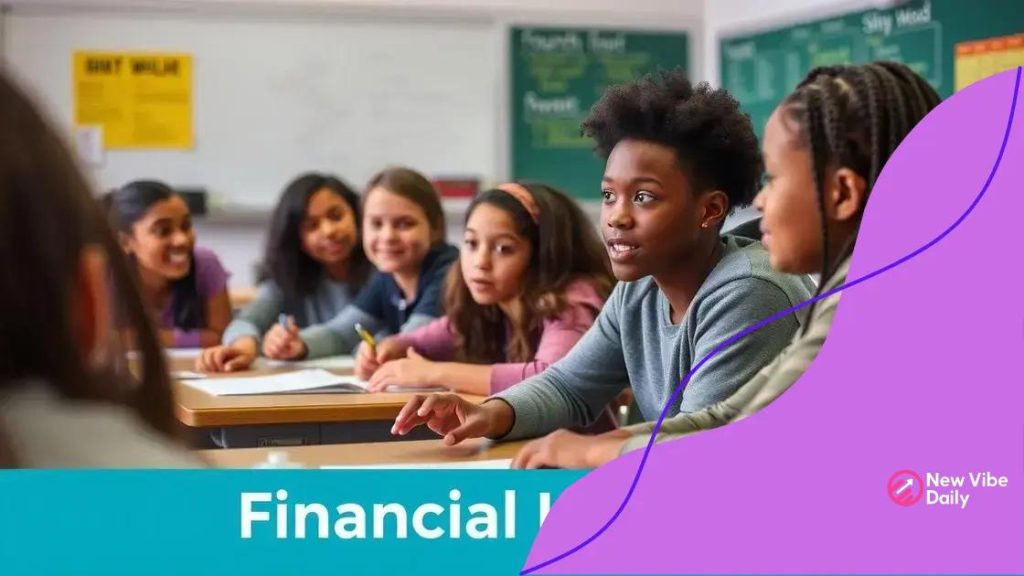The future of financial literacy education and its benefits

The future of financial literacy education focuses on innovative methods that leverage technology and practical application to enhance learning outcomes and equip individuals with vital financial management skills.
The future of financial literacy education is shaping how individuals manage their finances. Have you considered how these skills affect your daily decisions? Let’s dive into the evolving landscape of financial education.
The importance of financial literacy today
The importance of financial literacy today cannot be overstated. As the world becomes more complex, having a solid understanding of personal finance is crucial for everyone, especially young adults. Learning how to manage money empowers individuals to make informed decisions.
Understanding Financial Basics
To start, it’s essential to grasp the basics of finance. This includes knowing how to budget, save, invest, and understand credit. These foundational skills are key to building a secure financial future.
- Budgeting helps track income and expenses.
- Savings provide a safety net during emergencies.
- Investing builds wealth over time.
- Understanding credit protects against debt traps.
Next, financial literacy promotes financial health. When individuals are educated about finance, they can avoid making costly mistakes that lead to debt and stress. This knowledge fosters confidence in managing finances effectively.
The Long-term Benefits
Moreover, building financial literacy today sets the stage for a brighter future. With the right skills, young people can navigate their financial journeys with ease. This includes planning for big expenses like education, buying a home, or retirement.
Financial literacy can also encourage responsible spending habits. When individuals understand the value of money, they are less likely to fall into the traps of overspending and impulse buying. Strengthening these habits contributes to a stable financial life.
Challenges in current financial education systems
The challenges in current financial education systems are significant and multifaceted. Many programs struggle to keep pace with the evolving financial landscape, leading to gaps in knowledge. One of the major issues is that financial education often does not address the real-life situations faced by students.
Lack of Practical Application
Most financial education programs tend to be theoretical. Students learn concepts without understanding how to apply them in everyday life. This disconnect makes it hard for individuals to see the importance of managing their money.
- Lessons may focus on saving but ignore budgeting.
- Investment strategies can feel irrelevant if not contextualized.
- Real-world scenarios help solidify learning outcomes.
Moreover, access to quality financial education varies widely. In many areas, schools do not offer courses on personal finance, leaving students vulnerable to poor financial decision-making. Where programs do exist, they may not cater to diverse learning styles or cultural backgrounds.
Technology Gaps
Additionally, the rapid advancement of technology presents another challenge. Many traditional financial education programs do not incorporate modern tools that young people use daily. This results in a gap between what is taught and how finances are managed today.
Students are increasingly reliant on digital tools for budgeting, saving, and investing. To bridge this gap, educators must integrate these technologies into the curriculum. This integration can make learning more engaging and relevant.
Innovative approaches to teaching financial skills

Innovative approaches to teaching financial skills are changing the way we prepare individuals for managing their money. Traditional methods often fail to engage students and meet their real-life needs. By implementing new strategies, we can make financial education more effective and accessible.
Interactive Learning Experiences
One innovative method is the use of interactive learning experiences. This includes hands-on activities that simulate real-life financial decisions. For example, role-playing scenarios allow students to practice budgeting and making investment choices in a safe environment.
- Gamification makes learning fun and engaging.
- Students can learn through simulations of financial markets.
- Interactive tools like apps can reinforce lessons.
Additionally, project-based learning encourages students to tackle real-world financial issues. By working on projects that require financial planning, students gain practical experience. This approach also cultivates critical thinking and problem-solving skills.
Technology Integration
Another key aspect is technology integration. Utilizing digital tools and online platforms can enhance financial education. For example, online courses and webinars provide flexibility for learners to study at their own pace. Mobile apps for budgeting and savings help students apply what they learn immediately.
Moreover, social media can play a role in spreading financial literacy. Influencers and educators can share valuable tips and resources through engaging content. This makes financial education more relatable, especially for younger audiences.
The role of technology in enhancing financial literacy
The role of technology in enhancing financial literacy is significant in today’s digital age. Technology opens up new methods for teaching and learning about finance. With the right tools, people can access vital information more easily than ever.
Online Learning Platforms
Online learning platforms have revolutionized how we approach financial education. They offer courses on various financial topics that anyone can access from the comfort of their home. Through these platforms, learners can explore:
- Webinars featuring industry experts.
- Interactive courses that adapt to different learning styles.
- Quizzes and assessments that reinforce understanding.
Such resources allow individuals to learn at their own pace, fitting education into their schedules. This flexibility encourages participation among students who might not otherwise engage in traditional classroom settings.
Mobile Applications
Mobile applications also play a crucial part in promoting financial literacy. Many apps help users manage their finances effectively through:
- Budgeting tools that track spending and savings.
- Investment platforms that teach about market dynamics.
- Educational games that make learning fun and interactive.
By using these apps, individuals can apply concepts learned in a practical way. This immediacy enhances retention and understanding of financial principles.
Furthermore, social media serves as a powerful medium for spreading financial knowledge. Influencers and experts share tips, tricks, and resources through engaging content. When financial education reaches audiences via platforms they frequently use, the likelihood of engagement increases.
Measuring the impact of financial education programs
Measuring the impact of financial education programs is essential to understand their effectiveness. These programs aim to equip individuals with skills and knowledge for better financial management. However, it is crucial to assess whether they achieve their goals.
Methods of Measurement
There are various methods to evaluate the effectiveness of financial education programs. Surveys and assessments can gauge learners’ knowledge before and after completing a program. Tracking behavioral changes adds another layer of understanding to their impact.
- Pre- and post-program surveys to measure knowledge gained.
- Longitudinal studies to observe sustained behavioral changes.
- Focus groups to gather qualitative feedback from participants.
These methods can provide valuable insights into how well financial concepts are understood and applied in real life.
Behavioral Changes
Moreover, measuring behavioral changes is key. After participating in a program, individuals should ideally demonstrate improved financial habits. This might include better budgeting, increased savings, or more informed investment decisions.
Tracking these behaviors over time helps educators adjust their programs for better results. Understanding which aspects of the program led to positive outcomes allows for continual improvement and adaptation.
Furthermore, the long-term effects of financial education can be profound. Participants who receive quality financial training often experience greater financial stability. They are more likely to avoid debt and plan for the future.
FAQ – Frequently Asked Questions about Financial Education Programs
Why is measuring the impact of financial education programs important?
Measuring the impact helps determine the effectiveness of the programs and ensures that participants gain valuable financial skills.
What methods are commonly used to assess financial education programs?
Common methods include surveys, assessments before and after the program, and tracking behavioral changes over time.
How do financial education programs benefit participants in the long term?
These programs help participants develop better financial habits, leading to improved budgeting, saving, and overall financial stability.
What role does technology play in financial education?
Technology enhances financial literacy through online courses, mobile apps, and interactive tools that make learning more engaging and accessible.






